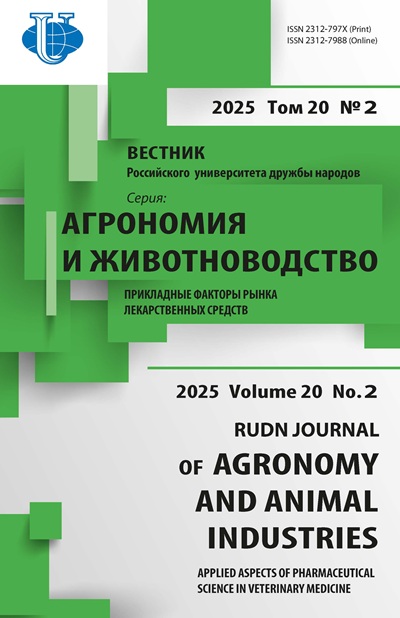Introducing Schizandra chinensis into the Southern Urals
- Authors: Bilalova R.A.1
-
Affiliations:
- Ufa Federal Research Center of the Russian Academy of Sciences
- Issue: Vol 17, No 4 (2022)
- Pages: 448-454
- Section: Crop production
- URL: https://agrojournal.rudn.ru/agronomy/article/view/19827
- DOI: https://doi.org/10.22363/2312-797X-2022-17-4-448-454
- ID: 19827
Cite item
Full Text
Abstract
Long-term introduction of Schizandra chinensis (Turcz.) Baill. was studied studying. The aim of the research was to assess the introduction resistance of Schisandra chinensis from the collection of lianas of South-Ural Botanical Garden-Institute, Ural Federal Research Center of the Russian Academy of Sciences. The 7 phenological growth stages were studied in 2014-2021. The prospects for introduction were determined according to P.I. Lapin and S.V. Sidneva, introduction resistance was assessed by the method of N.V. Trulevich. The following parameters were assessed: completeness of shoot development cycle, stability of rhythmic processes, vital state, life form, rate of ontogenesis, and renewal. According to the results of the research, lemongrass plants successfully passed the introduction tests. The species stably goes through all phases of seasonal development under cultivation, it is adapted to local climatic conditions and has high winter hardiness. Moreover, Schizandra chinensis is highly decorative throughout the growing season (more than 5 months). In accordance with the integral assessment, the taxon is assigned to the first group of prospects for introduction; Schisandra chinensis is a resistant plant. The crop is promising for use in recreational areas of Ufa and other settlements of the Southern Urals.
Full Text
Seasonal development of Schizandra chinensis
Growth stages | Years |
Mean | |||||||
2014 | 2015 | 2016 | 2017 | 2018 | 2019 | 2020 | 2021 | ||
Bb | 16.04 | 20.04 | 24.04 | 21.04 | 20.04 | 22.04 | 24.04 | 27.04 | 22.04±1.7 |
Bsg | 20.04 | 23.04 | 27.04 | 24.04 | 22.04 | 24.04 | 26.04 | 28.04 | 24.04±0.9 |
F1 | 25.05 | 28.05 | 28.05 | 18.05 | 22.05 | 20.05 | 23.05 | 17.05 | 23.05±1.5 |
F2 | 1.06 | 5.06 | 6.06 | 29.05 | 31.05 | 27.05 | 31.05 | 28.05 | 31.05±1.3 |
R | — | — | — | 02.09 | 04.09 | 30.08 | 08.09 | 30.08 | 2.09±1.7 |
C | 7.09 | 4.09 | 12.09 | 1.09 | 8.09 | 10.09 | 14.09 | 08.09 | 8.09±1.5 |
L | 23.09 | 17.09 | 25.09 | 14.09 | 24.09 | 28. 09 | 26.09 | 18.09 | 25.09±2.9 |
Note. Bb — bud bursting; Bsg — beginning of shoots growth; F1 — beginning of flowering; F2 — end of flowering; R — beginning of fruit ripening; C — autumn coloring of leaves; L — beginning of leaf fall.
About the authors
Roza A. Bilalova
Ufa Federal Research Center of the Russian Academy of Sciences
Author for correspondence.
Email: nroza@mail.ru
ORCID iD: 0000-0002-0449-6205
Candidate of Biological Sciences, Researcher, South-Ural Botanical Garden-Institute
195/3 Mendeleeva st., Ufa, Republic of Bashkortostan, 450080, Russian FederationReferences
- Kazarova SY. Seasonal rhythm of development of woody vines during introduction in the arboretum of the Botanical Garden of Lomonosov Moscow State University. In: Annals of Nature: phenology, responses of biota to climate change: conference proceedings. Moscow; 2020. p.104—107. (In Russ.).
- Usenko NV. Derev’ya, kustarniki i liany Dal’nego Vostoka [Trees, shrubs and lianas of the Far East]. Khabarovsk; 1984. (In Russ.).
- Nechaev AA. Resources of Schisandra chinensis in the Far East of Russia. Plodovodstvo, semenovodstvo, introduktsiya drevesnykh rastenii. 2016;XIX(1):69—72. (In Russ.).
- Lapaev II. Limonnik i ego lechebnye svoistva [Lemongrass and its medicinal properties]. 3rd ed. Khabarovsk; 1978. (In Russ.).
- Oshkina EV, Kolesnikova RD, Vyvodtsev NV, Tagiltsev YG. Chinese magnolia vine — t he far eastern volatile-oil-bearing plant. Russian forestry journal. 2014;(5):35—41. (In Russ.).
- Kozak NV, Kolbasina EI. Introduction and features of the technology of maintaining a collection of rare fruit vines — actinidia and magnolia vine in the Moscow region. Pomiculture and small fruits culture in Russia. 2012;34(1):341—347. (In Russ.).
- Orlin NA. On the biologically active substances of Schisandra chinensis. International Journal of Applied and Fundamental Research. 2009; (4):115. (In Russ.).
- Pavlov DV, Titov AY. Creation of a plantation of Schisandra chinensis in the Far East region. Plodovodstvo, semenovodstvo, introduktsiya drevesnykh rastenii. 2018;21:170—173. (In Russ.).
- Bilalova RA. Actinidia kolomikta (Maxim.) Maxim. — promising culture for the Southern Urals. Bulletin of SAU. 2021;(3):52—56. (In Russ.). doi: 10.36718/1819-4036-2021-3-52-56
- Yapparov FS, Khaibullin RI, Mukatanov AH. Rational use of soil landscapes in botanical gardens. In: Botanicheskie issledovaniya na Urale [Botanical research in the Urals]. Sverdlovsk: UrO AN SSSR; 1990. (In Russ.).
- Metodika fenologicheskikh nablyudenii v botanicheskikh sadakh SSSR [Methods of phenological observations in the botanical gardens of the USSR]. Moscow; 1975. (In Russ.).
- Lapin PI, Aleksandrova MS, Borodina NA, Makarov SN, Petrova IP, Tsitsin NV. Drevesnye rasteniya Glavnogo botanicheskogo sada AN SSSR [Woody Plants of the Main Botanical Garden of the USSR Academy of Sciences]. Moscow: Nauka publ.; 1975. (In Russ.).
- Lapin PI, Sidneva SV. Evaluation of the prospects for the introduction of woody plants according to visual observations. In: Opyt introduktsii drevesnykh rastenii [Experience of introduction of woody plants]. Moscow: Nauka publ.; 1973. p. 7—67. (In Russ.).
- Trulevich NV. Ekologo-fitotsenoticheskie osnovy introduktsii rastenii [Ecological and phytocenotic bases of plant introduction]. Moscow: Nauka publ.; 1991. (In Russ.).
- Zaitsev GN. Matematika v eksperimental’noi botanike [Mathematics in experimental botany]. Moscow: Nauka publ.; 1990. (In Russ.).
Supplementary files















